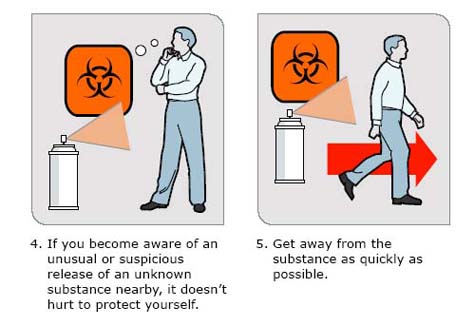World Weird Web: Too Much Information
Internet Users Worldwide Can Get More Data Than They'd Ever Want To
Unlike the national website – examined in a previous Weird SB column – of North Korea, the United States’ sites tend to be very official, providing information on everything from the GDP of Bulgaria to what to do in case of a bioterrorism attack. Our Homeland Security website, for example, offers oodles of helpful tips, as can be seen from the image accompanying this column. “Hmmmm,” the man in the image seems to be thinking, as the biological agent sprays onto his face. “I think there’s a symbol for that.”

Truly, Homeland Security has our best interests at heart – and a very pessimistic view of the average American’s intelligence.
For real intelligence, however, no American government website surpasses the official site of the CIA (Central Intelligence Agency). That site – obsessively updated every few days by either a team of hardworking subterranean intelligence gnomes or by the most dedicated and retentive clerical staff in the world – take your pick, is chock-full of the kind of facts and figures you never knew you wanted to know. Take the landlocked African nation of Chad. After browsing through the CIA’s country statistics on Chad for awhile, one could quickly learn that this nation might not be the best one to move to. Only 2.8 percent of Chad’s land is arable, for example, and infant mortality hovers around 10 percent, and the national life expectancy at birth is 47.43 years. The total revenue received yearly by the government of Chad is $1.889 billion. Compare this to, say, Libya – Chad’s northern neighbor – with its yearly revenue of $39.62 billion, and the dire economic situation of Chad becomes clear. Libya, it’s probably not necessary to add, is itself not one of the world’s most pleasant places to live.
Statistics, of course, are meaningless unless interpreted. Chad’s yearly water usage of 24 cubic meters per capita is an easy fact to pass over with hardly a glance, but some simple algebra puts this in perspective. A typical shower uses three gallons per minute. Let’s say a ten-minute shower is the average, and assume that each person in Santa Barbara takes one per day. Basing population statistics on the Santa Barbara Chamber of Commerce’s 2000 census data, Santa Barbara uses about 10,500 cubic meters of water every day – for showers alone.
That’s as much water as the average resident of Chad would use over the course of 439 years.
Of course, not all of the CIA’s facts and figures are as unsettling as those above. The website has a games page for kids, featuring a Natasha-esque female cartoon spy in a trenchcoat. The games are actually kind of fun, but how many parents send their children online to the CIA’s website for some light entertainment?
The kids’ page also features a link to the National Security Agency’s CryptoKids Page, which is basically an early recruiting site for children interested in cryptology, introduced by some of the creepiest looking cartoon animals ever inked. Kids, the site informs us, can learn all about codemaking and codebreaking while hanging out online with Crypto Cat, Decipher Dog, and other wacky characters.

Please note that the names of the entire CryptoKids gang are trademarked – no doubt to keep them out of terrorist hands.
Of course, there’s quite a bit on offer from the U.S. government online that falls in between Chad and the CryptoKids, but it’s a testament to the thoroughness of our government that these two informational extremes exist at all. The sheer volume of data available to anyone willing to look for it boggles the mind.
If nothing else, it’s a shining example of our tax dollars at work. Happy April!



